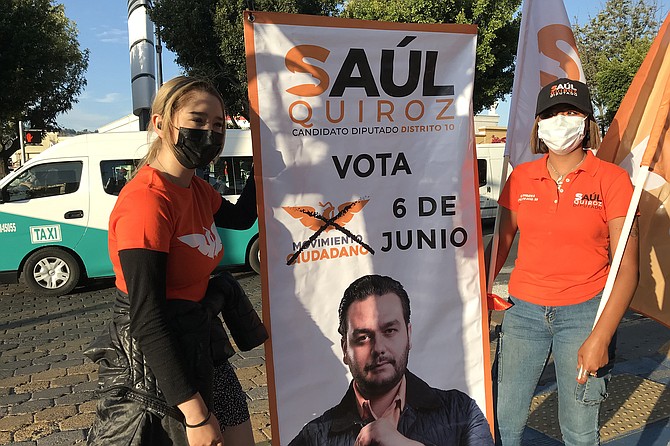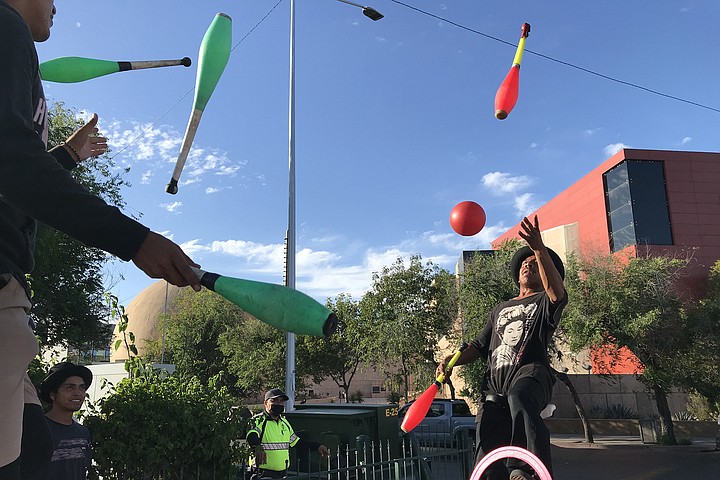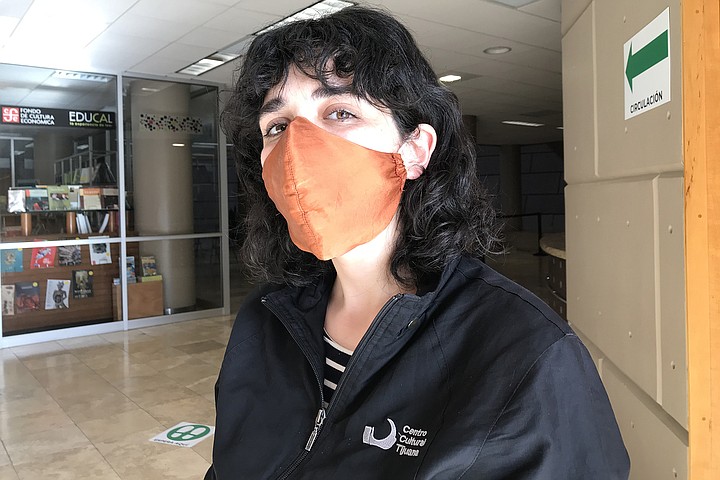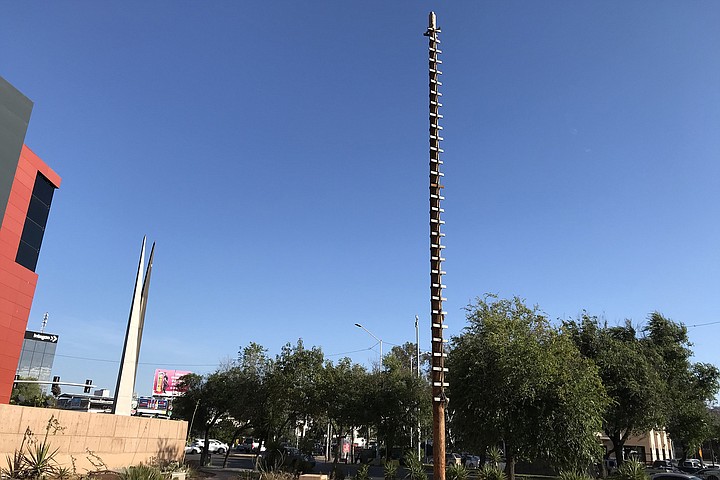 Facebook
Facebook
 X
X
 Instagram
Instagram
 TikTok
TikTok
 Youtube
Youtube

1.) “Lights! Let’s go!” yells Mario Alberto Ortiz Vargas. The whole crew grabs their clubs, rings, balls and unicycles, and charges out into the middle of Paseo de Los Héroes, where the rush-hour traffic has screeched to a halt. Already, the guys are up on their unicycles, flinging juggling clubs and balls at each other through the air. They do a frantic 40-second acro-ballet, while the nonplussed drivers and their spouses stare up through their windscreens and then laugh, until suddenly Mario barks something, and the guys bow and take off back to the center divide. Meanwhile, Mario zips ‘round the drivers’ side windows with a collection box, then makes it out of harm’s way just as the lights turn green and traffic roars ahead.

Magic’s over, for another two minutes.
“Ah,” says Mario. They’re all sitting in the center divide when one of the guys turns up with two steaming boxes of Manolo’s Pizza “Manolo’s Centro outlet makes the best pies,” says one of the jugglers, Jose Guadalupe Figueroa Castillo. Within moments, the pies are gone. Everyone munches. Jose is Tijuanense, the only one of the four who’s not from Mexico City. But all have been doing this gig a long time. They each are around 26 years old. Mario Alberto Ortiz Vargas has been at it for 7 years. Jose Emanuel too. “You just learn on the job,” he says. “You’ve got to be quick. Our job is to wake up all these bored people in 40 seconds. We’re malabaristas! (jugglers) That’s our job.”
“Lights!” yells Mario.

Everybody drops everything.
2.) Around on the next side of the “Tijeras” (“Scissors”), the double-spiked monument to Mexican independence, it’s another set of lights, another pair of entertainers. Genesis Velasco makes sure her football socks are up and her yellow whistle is secure around her neck. Traffic stops. Her buddy Jesus Padillo hurries out into the middle of Boulevard Independencia carrying a portable black cloth screen. Genesis reaches for a soccer ball in front of it, starts making it run across her shoulders, bops it on top of her head, up in the air. Then a strange thing happens. She and it are suddenly moving in slow motion, like the projector has slowed down. And, incredibly, the soccer ball lifts in the air slowly too, arcs down even slower. It’s like the whole world has switched to slo-mo. You can see drivers behind their windscreens saying, “What thu...?”
Genesis looks just as mystified. Her puzzled face beseeches the car audience for help. Until, just as instantly, things click back into full speed again. Genesis shrugs her shoulders, laughs, and races in amongst the cars with a collection box. She has about 10 seconds before the lights change.

“We’re from Guadalajara,” she says, two minutes later. “We’ll spend about three weeks here.” She and her partner Jesus are standing against the fence now, counting the coins. “Do we do it for the money?” she says. “Of course, but it’s mainly for the fun, people’s reactions.”
Marcel Marceau and others from the European school of mime helped inspire them. But actually, these are pretty ancient arts in Mexico that they’re following, like acrobatics, since well before the conquistadors. “It’s like instant theater,” she says. “Just an impression.” Besides, in this noise, trying to say something funny just wouldn’t work. Who’d hear it? This you can do without words, without musical instruments, without border language issues, but still making them ooh and aah.
These are moments when TJ reminds me of Paris. And the beauty is here you have this fine boulevard plus a fresh audience. New world! New possibilities!

3.) On the “Tijeras”’s third side, it’s more show, but more serious. A bunch of students at those “scissors,” Glorieta Independencia, the twin-needle monument that anchors the Paseo de Los Heroes, waits for their moment in the lights, then rush around with orange flags and fliers to hand to drivers. “Saul Quiroz, Candidato Diputado Distrito 10,” say their signs. An eagle holding a snake in its beak, the symbol of Mexico, is also the symbol of their party, the Citizens’ Movement. The girls have long eyelashes and orange eyeliner which goes luminous in the setting sun’s rays.

“Can I help you?” says this beefy guy. Turns out he is Saul Quiroz, the candidate himself. He says campaigning is fun, but politics on this side of the line is serious business. “We have already had two candidates killed in this election cycle,” he says. (This is Friday, 10 days before the June 6th election). Then he’s back to handing out pamphlets while the students flap flags around him.
4.) The fourth side of the Tijeras monument? CECUT! Centro Cultural. The magnificent ball-shaped cultural center that opened in 1982 with the aim of promoting cultural tourism from the U.S. The last twenty years have been cruel to that dream. But at least they have a bona fide cultural center in their city. Do we?
On the other hand, just looking at these four sides of the Independence Monument, it is the other three that are full of impromptu life, while this whole vast plaza is magnificent, important, but asleep. At least on the outside. You’ve got to recognize the devastation of covid: The magnificent ball which is the Centro Cultural’s Omnimax theater and the jewel in its crown, is open, but only just. “We are opening by stages,” says Sofia Joffre, who is the staffer welcoming you at the entrance. Their permanent exhibitions are open, but this still sort of reminds me of San Diego’s chronically-empty Horton Plaza before it began its transformation into a tech hub. All dressed up with prize-winning design, and yet, missing life. “We do normally get one million visitors a year,” Sofia justifiably points out.
This is when I spot the one piece of rough architecture in the whole carefully-planned center: the 100-foot timber pole from which the Aztec voladores traditionally “fly.” I recognize this from Barrio Logan. On certain days, men (and it customarily is men) attach ropes and imitate birds, “flying” round and round above the ground, imitating the original “dance” that sought to appease the gods during a historic drought.
“You ought to see when they do it, senor,” says the guard. “Omnimax is good, but this is real, in front of your eyes. People are hypnotized.”


1.) “Lights! Let’s go!” yells Mario Alberto Ortiz Vargas. The whole crew grabs their clubs, rings, balls and unicycles, and charges out into the middle of Paseo de Los Héroes, where the rush-hour traffic has screeched to a halt. Already, the guys are up on their unicycles, flinging juggling clubs and balls at each other through the air. They do a frantic 40-second acro-ballet, while the nonplussed drivers and their spouses stare up through their windscreens and then laugh, until suddenly Mario barks something, and the guys bow and take off back to the center divide. Meanwhile, Mario zips ‘round the drivers’ side windows with a collection box, then makes it out of harm’s way just as the lights turn green and traffic roars ahead.

Magic’s over, for another two minutes.
“Ah,” says Mario. They’re all sitting in the center divide when one of the guys turns up with two steaming boxes of Manolo’s Pizza “Manolo’s Centro outlet makes the best pies,” says one of the jugglers, Jose Guadalupe Figueroa Castillo. Within moments, the pies are gone. Everyone munches. Jose is Tijuanense, the only one of the four who’s not from Mexico City. But all have been doing this gig a long time. They each are around 26 years old. Mario Alberto Ortiz Vargas has been at it for 7 years. Jose Emanuel too. “You just learn on the job,” he says. “You’ve got to be quick. Our job is to wake up all these bored people in 40 seconds. We’re malabaristas! (jugglers) That’s our job.”
“Lights!” yells Mario.

Everybody drops everything.
2.) Around on the next side of the “Tijeras” (“Scissors”), the double-spiked monument to Mexican independence, it’s another set of lights, another pair of entertainers. Genesis Velasco makes sure her football socks are up and her yellow whistle is secure around her neck. Traffic stops. Her buddy Jesus Padillo hurries out into the middle of Boulevard Independencia carrying a portable black cloth screen. Genesis reaches for a soccer ball in front of it, starts making it run across her shoulders, bops it on top of her head, up in the air. Then a strange thing happens. She and it are suddenly moving in slow motion, like the projector has slowed down. And, incredibly, the soccer ball lifts in the air slowly too, arcs down even slower. It’s like the whole world has switched to slo-mo. You can see drivers behind their windscreens saying, “What thu...?”
Genesis looks just as mystified. Her puzzled face beseeches the car audience for help. Until, just as instantly, things click back into full speed again. Genesis shrugs her shoulders, laughs, and races in amongst the cars with a collection box. She has about 10 seconds before the lights change.

“We’re from Guadalajara,” she says, two minutes later. “We’ll spend about three weeks here.” She and her partner Jesus are standing against the fence now, counting the coins. “Do we do it for the money?” she says. “Of course, but it’s mainly for the fun, people’s reactions.”
Marcel Marceau and others from the European school of mime helped inspire them. But actually, these are pretty ancient arts in Mexico that they’re following, like acrobatics, since well before the conquistadors. “It’s like instant theater,” she says. “Just an impression.” Besides, in this noise, trying to say something funny just wouldn’t work. Who’d hear it? This you can do without words, without musical instruments, without border language issues, but still making them ooh and aah.
These are moments when TJ reminds me of Paris. And the beauty is here you have this fine boulevard plus a fresh audience. New world! New possibilities!

3.) On the “Tijeras”’s third side, it’s more show, but more serious. A bunch of students at those “scissors,” Glorieta Independencia, the twin-needle monument that anchors the Paseo de Los Heroes, waits for their moment in the lights, then rush around with orange flags and fliers to hand to drivers. “Saul Quiroz, Candidato Diputado Distrito 10,” say their signs. An eagle holding a snake in its beak, the symbol of Mexico, is also the symbol of their party, the Citizens’ Movement. The girls have long eyelashes and orange eyeliner which goes luminous in the setting sun’s rays.

“Can I help you?” says this beefy guy. Turns out he is Saul Quiroz, the candidate himself. He says campaigning is fun, but politics on this side of the line is serious business. “We have already had two candidates killed in this election cycle,” he says. (This is Friday, 10 days before the June 6th election). Then he’s back to handing out pamphlets while the students flap flags around him.
4.) The fourth side of the Tijeras monument? CECUT! Centro Cultural. The magnificent ball-shaped cultural center that opened in 1982 with the aim of promoting cultural tourism from the U.S. The last twenty years have been cruel to that dream. But at least they have a bona fide cultural center in their city. Do we?
On the other hand, just looking at these four sides of the Independence Monument, it is the other three that are full of impromptu life, while this whole vast plaza is magnificent, important, but asleep. At least on the outside. You’ve got to recognize the devastation of covid: The magnificent ball which is the Centro Cultural’s Omnimax theater and the jewel in its crown, is open, but only just. “We are opening by stages,” says Sofia Joffre, who is the staffer welcoming you at the entrance. Their permanent exhibitions are open, but this still sort of reminds me of San Diego’s chronically-empty Horton Plaza before it began its transformation into a tech hub. All dressed up with prize-winning design, and yet, missing life. “We do normally get one million visitors a year,” Sofia justifiably points out.
This is when I spot the one piece of rough architecture in the whole carefully-planned center: the 100-foot timber pole from which the Aztec voladores traditionally “fly.” I recognize this from Barrio Logan. On certain days, men (and it customarily is men) attach ropes and imitate birds, “flying” round and round above the ground, imitating the original “dance” that sought to appease the gods during a historic drought.
“You ought to see when they do it, senor,” says the guard. “Omnimax is good, but this is real, in front of your eyes. People are hypnotized.”
Comments